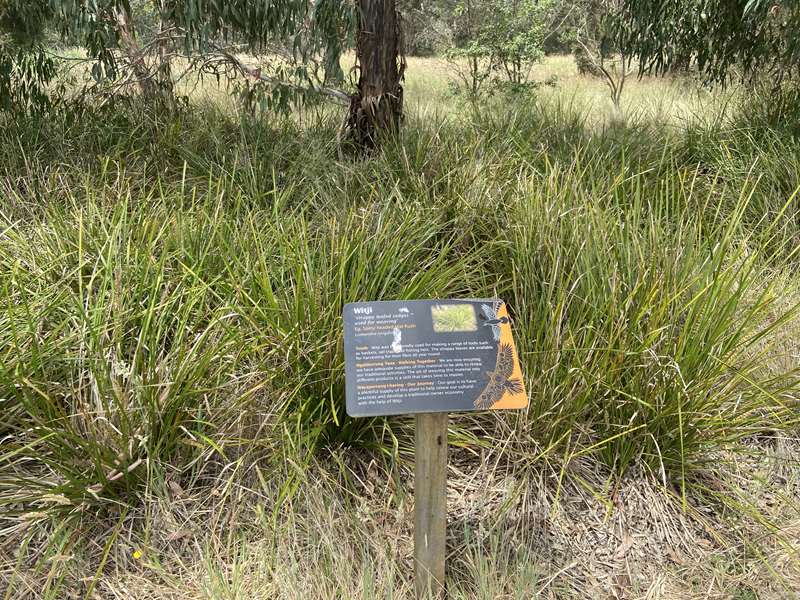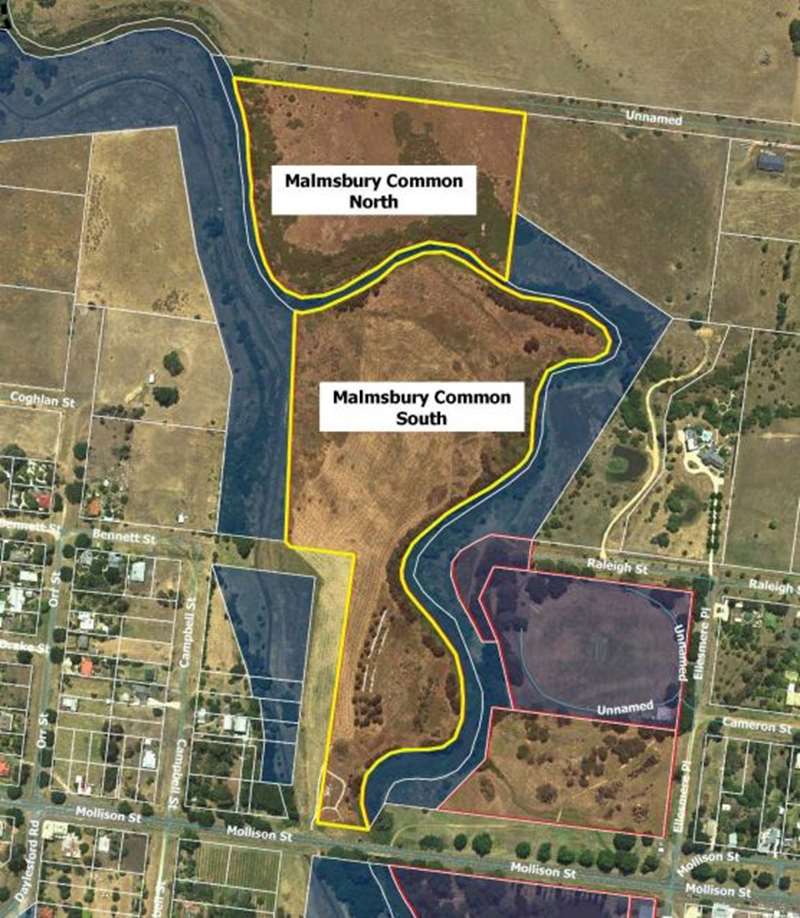Malmsbury Common


Malmsbury Common is a highly valued conservation reserve which contains significant native grasslands, wetlands and stream bank vegetation.
The Common is located opposite the Malmsbury Botanic Gardens.
Map of Malmsbury Common

Platypus are known to live in the river and it's the perfect spot for bird watching.
Signs have been installed which speak to the values of the Djaara people as reflected in place, the waterway and specific food and fibre plants that you would find there. These include the Dja Dja Wurrung Djaa-ndak-i (Welcome to Dja Dja Wurrung Country), the Kapa Gatjin (Knowing Water) and the Manya (Meeting Place, a Cultural Place).
Six interpretative signs are located along the trail - Buwatj, Witji, Gitawil Matom, Murna, Dhurrung Wurrkuk and River Mint. These provide information on how plants were used and how people are together relearning their cultural importance. The sign locations will capture displays of plants, some of which are already in situ, others are yet to be planted and will be developed over time.
Interpretative Signs
Kapa Gatjin - Knowing Water
Water sustains us - Our waterways provide food, medicine, resources and a way to travel through Country. They are a place to meet, gather, camp, hunt, fish, swim and hold ceremony. They are places that are central to our creation stories. Many of our cultural heritage sites are located along waterways. Dja Dja Wurrung men would have traditionally used a variety of specialized fishing techniques. We made hand crafted fishing spears, fishing nets and eel traps and used weirs and canoes to sustainably harvest what we needed.
Our Journey - We aim to ensure all of our waterways are healthy, with the right water in the right place at the right time to meet the needs of the environment, Djaara People and the broader community. We work with the community and partner agencies to restore health to the Coliban River and other waterways on Dja Dja Wurrung Country.
River Mint
Truth - We've lost the traditional Dja Dja Wurrung name for scented herbs such as River Mint, but we know it was an important plant for it's use as a seasoning and flavouring in food and drinks. It was also used as a medicine to treat coughs and colds. The leaves can be crushed and inhaled.
Ngaldurrung Yana - Walking Together - This small ground cover herb a very popular scented ornamental garden plant. We are replanting this important crop as an edible herb and for use as a traditional medicine.
Wayaparrang-i-baring - Our Journey - This plant has commercial potential as a culinary herb. It's great as a tea or in a fruity cocktail or sprinkled over your roast dinner. We hope to promote this plant to the community as the most appropriate mint for gardens on Dja Dja Wurrung Country.
Gitjawil Matom
'perennial herbs with edible tubers and scented flowers' eg. Pale Vanilla Lily and Chocolate Lily
Truth - These traditional food crops were planted, managed and harvested as very significant food crops for Dja Dja Wurrung people. Grazing by hard hoofed animals such as sheep and cows destroyed the crops and compacted the soil, resulting in widespread hunger for our people.
Ngaldurrung Yana - Walking Together - We are relearning how to grow these tuberous crops once again. You can notice them by their strong scent and white (Vanilla lily) or purple (Chocolate lily) flowers.
Wayaparrang-i-baring - Our journey - The underground tubers are like sweet potato or yams and can be used in the modern kitchen in many different recipes. Add these to your vegie garden, they're delicious raw, or roasted with salt and butter!
Witji
'strappy leafed sedges used for weaving' Eg. Spiny headed Mat Rush
Truth - Witji was traditionally used for making a range of tools such as baskets, eel trap and fishing nets. The strappy leaves are available for harvesting for their fibre all year round.
Ngaldurrung Yana - Walking Together - We are now ensuring we have adequate supplies of this material to be able to renew our traditional activities. The art of weaving this material into different products is a skill that takes time to master.
Wayaparrang-i-baring - Our journey - Our goal is to have a plentiful supply of this plant to help renew our cultural practices and develop a traditional owner economy with the help of Witji.
Murna
Yam Daisy
Truth - This traditional food crop was planted, managed and harvested as a very significant food crop for Dja Dja Wurrung people because the milky tuber was available all year round. Grazing by hard hoofed animals such as sheep and cows destroyed the crops and compacted the soil, resulting in widespread hunger for our people.
Ngaldurrung Yana - Walking Together - We are now relearning how to grow this crop again. Djaara women use fire to rejuvenate the landscape before planting and traditional digging sticks as a gardening tool for planting and harvesting.
Wayaparrang-i-baring - Our Journey - The roasted tubers can be used in the modern kitchen in many different recipes. They're yummy! It can be eaten raw or roasted in an earth oven to produce a sweet syrupy tuber much like a sweet potato or yam. Try to grow these at home instead of spuds.
Buwatj
'grasses used for seed' Eg. Kangaroo Grass
Truth - Kangaroo Grass was grown widely as a traditional food crop of the Djaara people. The grain was collected in coolamons, ground into a flour with grinding stones and mixed with water to create a dough. Changing land use damaged the fields resulting in the loss of this very useful and healthy plant.
Ngaldurrung Yana - Walking Together - We are now renewing our traditional ways of cultivating it as a low water use crop that grows on a range of soil types. We are trialling perennial grasses for use in agriculture and to help us care for Country.
Wayaparrang-i-baring - Our Journey - Djaara women lead the planting, management and harvesting of this plant using fire as a tool. We want to share this crop to make damper, cakes and beverages that haven't been available for many years.
Dhurrung Wurrkuk
'broad, soft, strappy leafed plants used for weaving' Eg. Spreading Flax Lily
Truth - Dhurrung Wurrkuk has broad flat leaves which are used to make baskets, nets and eel traps. Djaara women split the leaves down the midrib and twist them together to make a range of products. The roots are also prepared correctly and then eaten. The purple berries are not eaten by Dja Dja Wurrung people but are useful as a purple dye.
Ngaldurrung Yana - Walking Together - We are replanting this important crop for food, fibre and dye to ensure there's enough of it to renew our traditional cultural practices and to develop our traditional owner economy.
Wayaparrang-i-baring - Our Journey - We are renewing the arts of weaving, processing and cooking with this plant and hope to teach our children these traditional skills.
Manya A Meeting Place, a Cultural Place
The Coliban River is an important cultural place for Dja Dja Wurrung people. This area is known for its rich collection of scar trees, cultural artefacts, and stone quarries. Large stone tool scatters and evidence of quarry and processing sites can be found along the main channel.
Local resources lead to trade - Greenstone, tachylite and quartz are found in this region and were quarried and refined by Djaara people to make high quality tools that were traded as a valuable commodity. Greenstone axe-heads were especially prized.
Trade leads to culture - Camping was common here due to the rich resources and access to water. Big gatherings with neighbouring mobs occurred here to obtain raw materials which were fashioned into objects and traded with our neighbours. Relationships were developed between families, ceremony was practiced and alliances were formed.
Access for Dogs:
Dogs are permitted on leash.
Review:
The reserve is located west of the bridge on the Calder Highway across the Coliban River. There is space for some parking beside the road.
There is a path, initially concrete and then stony gravel, through the reserve with plenty of information signs about Indigenous plants. There is a table and some seats beside the path. The track eventually peters out near a mound and you retrace your steps with the return walk being about 1km in length. In Spring there were a few nice flowers along the path.
Photos:
Location
96 Mollison Street, Malmsbury 3446 Map









